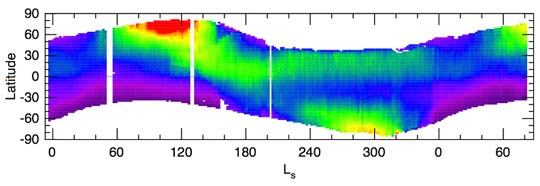
Seasonal Trend in Water Vapor Seen from Orbit
12/13/04
The seasonal trend in the amount of water vapor in Mars' atmosphere, as observed by thermal emission spectrometer on NASA's Mars Global Surveyor orbiter, varies by latitude. This plot starts near the beginning of fall in the southern hemisphere for the year before the Mars Exploration Rover mission began and ends on August 30, 2004, slightly more than one martian year later. Purple represents no water while red represents about 50 precipitable micrometers, which is about 10,000 times less than on Earth. The units of time along the horizontal axis are given in longitude of the Sun (Ls) as measured in a Mars-centered coordinate system, a way to reflect the elliptical nature of Mars' orbit. On this scale, Mars is farthest from the Sun at about 74, which also corresponds to late fall in the southern hemisphere.
During the period when Mars is farthest from the Sun, the migration of water vapor from the northern polar region combines with lowered atmospheric temperatures to produce conditions that allow formation of clouds such as seen in the image at http://www.jpl.nasa.gov/missions/mer/images.cfm?id=1403. Opportunity is further north than Spirit is, so there is a distinct difference in the amount of water vapor available to form water-ice clouds over the two sites. To date, Spirit has not seen any discrete, cirrus-like clouds such as Opportunity has photographed. Although water vapor is expected to reach a maximum abundance for the Opportunity and Spirit sites near spring equinox (Ls 180 or about March 2005), the atmospheric temperatures will very likely have warmed sufficiently to prevent formation of the type of clouds that Opportunity has observed recently.
Image Credit: NASA/JPL/ASU/GSFC
+ Medium resolution version of this image
+ High resolution version of this image
+ Print this image and caption
|




